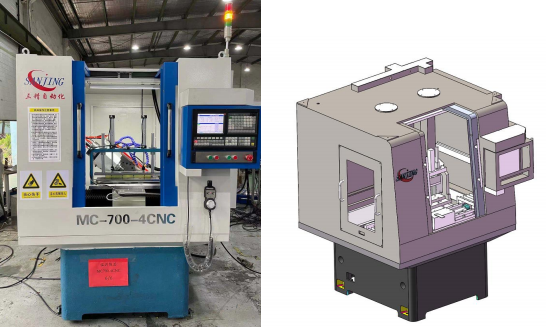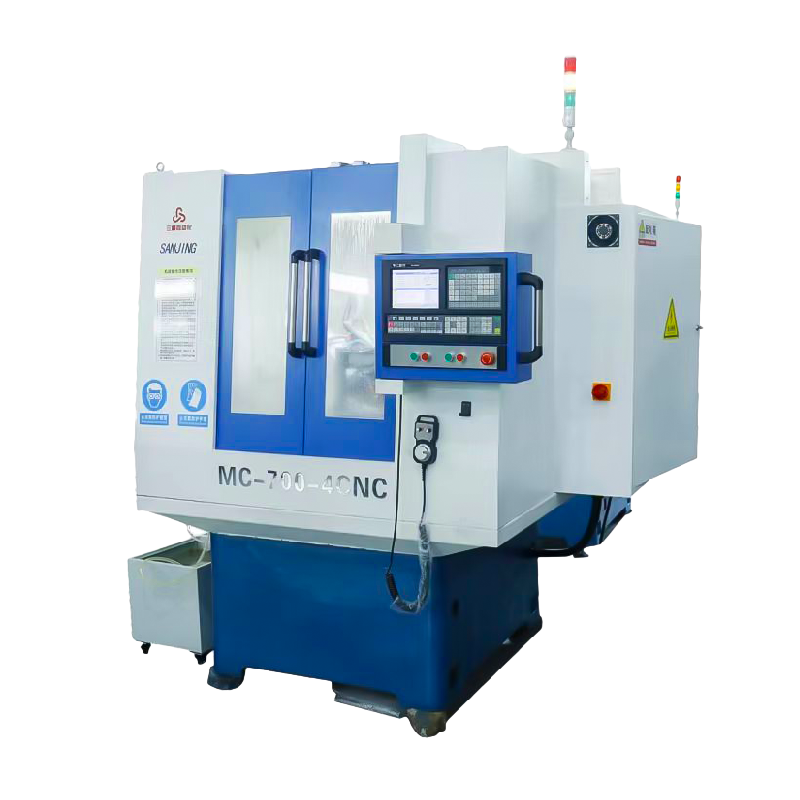Product Main Parameters
| Effective Travel X-axis | 680mm |
| Y-axis | 80mm |
| B-axis | ±50° |
| C-axis | -5-50° |
| NC Electro-spindle | 4000-12000r/min |
| Grinding Wheel Diameter | Φ180 |
| Size | 1800*1650*1970 |
| Efficiency (for 350mm) | 7min/pcs |
| System | GSK |
| Weight | 1800kg |
| Model | MC700-4CNC |
Common Product Specifications
| Maximum Processing Line | 800mm |
| Tool Setting and Feeding | Full Servo |
| Grinding Operation Tolerance | 0.01mm |
| Straight Blade Grinding | Blade length <600mm |
Product Manufacturing Process
Computerized milling machines utilize advanced technology integrating CAD/CAM software to convert intricate designs into precise physical components. This manufacturing involves pre-programmed sequences of machine control commands known as G-code, which facilitates the control of cutting tools and other machine components. Automated processes enhance precision and reduce human error, allowing for the production of complex components with tight tolerances. The result is highly accurate and consistent output, crucial for high-demand industries.
Product Application Scenarios
Computerized milling machines find applications across diverse industries, including aerospace, automotive, electronics, and medical devices. Their ability to produce complex parts with precision makes them indispensable for manufacturing components with intricate geometries and tight tolerances, such as aerospace components or medical devices. Furthermore, their versatility in handling a wide range of materials like metals, plastics, and composites means they are suitable for various manufacturing tasks, from prototyping to mass production.
Product After-Sales Service
We provide comprehensive after-sales service including onsite installation and maintenance support. Our skilled technicians are available to address any operational concerns and ensure your milling machine operates at peak efficiency. Additionally, we offer a warranty on all our products, coupled with a dedicated customer support team to handle inquiries and service requests.
Product Transportation
Our computerized milling machines are shipped globally with comprehensive packaging to ensure protection during transit. We collaborate with reputable logistics partners to offer various delivery options suited to your needs, ensuring timely and secure arrival at your location.
Product Advantages
- High precision and repeatability
- Versatility in material handling
- Enhanced automation for increased productivity
- Reduction in labor costs due to minimal supervision
- Capability to operate continuously, maximizing output
Product FAQ
- What materials can the computerized milling machine handle?
Our computerized milling machines can work with a range of materials, including metals, plastics, wood, and composites, allowing for diverse manufacturing capabilities.
- How does the CNC system improve precision?
The CNC system reduces human error by automating the cutting process, ensuring high precision and consistency, crucial for complex part production.
- What are the maintenance requirements for a computerized milling machine?
Regular maintenance involves cleaning, lubrication, and periodic inspections to ensure optimal performance and longevity of the machine.
- Can the milling machine operate unattended?
Yes, once programmed and calibrated, our machines can operate autonomously, requiring minimal supervision, thus boosting productivity and efficiency.
- How do you handle customer training for using the machines?
We offer comprehensive training programs to equip your team with the necessary skills for operating and maintaining your computerized milling machine.
- What software is compatible with your CNC milling machines?
Our machines are compatible with various CAD/CAM software, allowing for seamless integration into your existing manufacturing processes.
- How do computerized milling machines ensure safety during operation?
Our machines are designed with safety features, including emergency stop functions and protective enclosures to prevent operational hazards.
- What industries benefit from using your milling machines?
Industries such as aerospace, automotive, electronics, and medical devices benefit significantly from the precision and efficiency of our milling machines.
- What makes your milling machines stand out from competitors?
Our commitment to precision, reliability, and innovation positions our machines as leaders in the industry, providing unmatched performance and versatile applications.
- What should be considered when choosing the right milling machine?
Consider factors such as material compatibility, precision requirements, machine capacity, and integration into existing workflows to determine the best machine for your needs.
Product Hot Topics
- The Future of Computerized Milling Machine Technology
As technology advances, computerized milling machines are expected to incorporate features like artificial intelligence and enhanced automation, pushing the boundaries of precision and efficiency further. Such advancements will make manufacturing processes more streamlined, enabling manufacturers to produce even more complex parts with unprecedented accuracy. The ongoing integration of AI in manufacturing processes necessitates a focus on developing adaptable and dynamic milling systems that can learn and improve over time, setting new standards in the industry.
- Choosing the Right Computerized Milling Machine
Selecting the appropriate milling machine involves understanding your specific manufacturing requirements, including material handling, precision levels, and automation needs. Our machines cater to diverse applications, offering customizable options to suit different production environments. By evaluating these factors and seeking guidance from experienced manufacturers, you can ensure your investment meets both current demands and future growth potential, optimizing your manufacturing processes for success.
- Enhancing Manufacturing with Computerized Milling Machines
Computerized milling machines enhance manufacturing by providing a seamless combination of precision, versatility, and efficiency. These machines empower manufacturers to pivot quickly between different production tasks, accommodating complex designs and reducing lead times. The ongoing evolution of CNC technology continues to transform manufacturing processes, as companies adopt these machines to remain competitive and deliver quality products to their markets.
- Impact of Computerized Milling Machines on Production Efficiency
The introduction of computerized milling machines has significantly increased production efficiency by automating complex machining tasks that previously required substantial manual effort. This automation has reduced errors and scrap rates, cutting costs and boosting throughput. Moreover, the ability to operate unattended allows manufacturers to extend production hours beyond regular shifts, optimizing output and meeting tighter delivery schedules, even in high-demand periods.
- Computerized Milling Machines in the Medical Industry
The medical industry relies on precise and intricate components that are often best produced using computerized milling machines. These machines ensure that critical parts for medical devices meet stringent quality and safety standards. As demand for advanced medical technology grows, computerized milling machines are increasingly critical for producing reliable components essential to patient care and safety in this rapidly evolving field.
- Advancements in CNC Software for Milling Machines
Recent advancements in CNC software have simplified the programming process for computerized milling machines, making them more accessible to operators and enhancing machine capability. This progression in software technology has enabled manufacturers to push the limits of conventional machining, achieving complex geometries and fine tolerances with increased ease, thus broadening the scope of potential applications across various industries.
- Environmental Benefits of Computerized Milling Machines
Computerized milling machines offer environmental benefits by optimizing material use and minimizing waste through precise cutting capabilities. This efficiency reduces raw material consumption and energy usage, contributing to more sustainable manufacturing practices. As environmental concerns become more prominent, adopting these advanced machines aligns manufacturing operations with eco-friendly standards, meeting both regulatory requirements and customer expectations for sustainability.
- The Role of Computerized Milling Machines in Industry 4.0
Computerized milling machines play a pivotal role in Industry 4.0 by integrating seamlessly with smart manufacturing systems, enabling real-time data analysis and process control. This integration allows manufacturers to monitor machine performance, optimize production flows, and adapt to changing demands swiftly. As digital transformation accelerates, the role of sophisticated CNC milling technologies becomes increasingly central to building intelligent, connected factories.
- Training and Workforce Development for CNC Milling
As the demand for skilled operators to manage computerized milling machines grows, companies must invest in comprehensive training and workforce development programs. These initiatives ensure that staff are proficient in operating and maintaining advanced machinery, facilitating smooth integration into manufacturing processes. By fostering a knowledgeable workforce, manufacturers can leverage the full potential of their CNC milling machines, driving innovation and productivity gains in their operations.
- Customizable Solutions with Computerized Milling Machines
Our computerized milling machines offer customizable solutions tailored to meet unique production requirements. Working closely with manufacturers, we develop machines that integrate seamlessly with existing processes, optimizing performance and output. Whether adapting to specific material needs or enhancing precision capabilities, these customizable options ensure that our machines deliver high-value solutions, maintaining efficiency and competitiveness in various industrial settings.
Image Description




